More Than 9 Suitors Court London Metal Exchange

Interest in the London Metal Exchange as a takeover target has snowballed and the number of suitors has risen to double digits because business is booming with volumes at record levels, its chief executive Martin Abbott said.
The LME will set up a data room, opening the books for would-be buyers, by early December.
There's been a huge amount of global interest, more than nine people have shown an interest, Abbott told Reuters on Wednesday.
April at the earliest would be the time that we would take something to shareholders. If we decide there is anything to take to them.
The LME, the world's biggest market for industrial metals, said on Friday it was considering a sale after receiving several expressions of interest.
Metal industry sources have said the bid could be worth a potential 1 billion pounds ($1.57 billion), a figure that Abbott said did not come from the exchange. They also said an approach in 2008 had valued the exchange at 800 million pounds.
Utter, total fabrication, I don't know where that came from, it never happened, Abbott said.
There is market speculation that the list of potential acquirers may include CME Group Inc , the largest futures exchange in the United States, IntercontinentalExchange and UK-based broker ICAP .
Singapore Exchange , the recently launched Hong Kong Mercantile Exchange, the London Stock Exchange , and Eurex owned by Deutsche Boerse have also been mentioned by metals sources.
Abbott declined to comment on which companies had expressed interest in buying the exchange or on any valuations.
If we look at one, we should look at more than one and very quickly it snowballed, so we got a lot of people who are interested, he said.
SWEET SPOT
Any deal would have to be accepted by 75 percent of shareholders. Major LME shareholders include companies such as U.S. banks Goldman Sachs and JP Morgan and trading firms including Amalgamated Metal Trading and Metdist.
The LME is in great shape, and therefore if someone really wants to buy the LME, they are going to have to persuade the shareholders to sell it, Abbott said.
The LME was established in 1877 above a London hat shop.
Its building on Leadenhall Street in the City financial district is one of the last bastions of open outcry, with futures in metals including copper, aluminum, zinc, lead, tin and nickel still changing hands in so-called ring trading as well as electronically and over the telephone.
Trading houses and banks that use the market also own it and therefore the fees are kept low.
The LME, which accounts for 80 percent of traded volume in global metal futures transactions, saw record trading volumes last year of 120 million lots equivalent to $11.6 trillion and 2.8 billion tonnes of metal.
Our trading volume is up 19 percent year to date, we're in a sweet spot, commodities obviously as a class are very very attractive at the moment, Abbott said.
Pre-tax profit in 2010 fell 28 percent to 12.5 million pounds, a modest number partly due to the low fees.
It's deliberately run on that basis, Abbott said.
So yes, one has to assume that if there were to be a transaction it would be because someone has actually calculated to the satisfaction of the shareholders what the value of the LME in a fully commercial world would look like.
Only the A or ordinary shareholders are entitled to vote and receive dividends. There are 14.851 million A shares in issue and 2.49 million B shares in issue.
The last bid for A shares stands at 5.50 pounds and the last offer for B shares is 78 pounds.
Any number that is constructed by looking at our historical accounts is of no practical value, Abbott said.
It would be a very bold person who came in, wrote a check that was large enough to entice the shareholders to sell and then said we are going to change everything. ($1 = 0.639 British Pounds)
(Reporting by Pratima Desai; Editing by Anthony Barker)
© Copyright Thomson Reuters 2024. All rights reserved.





















